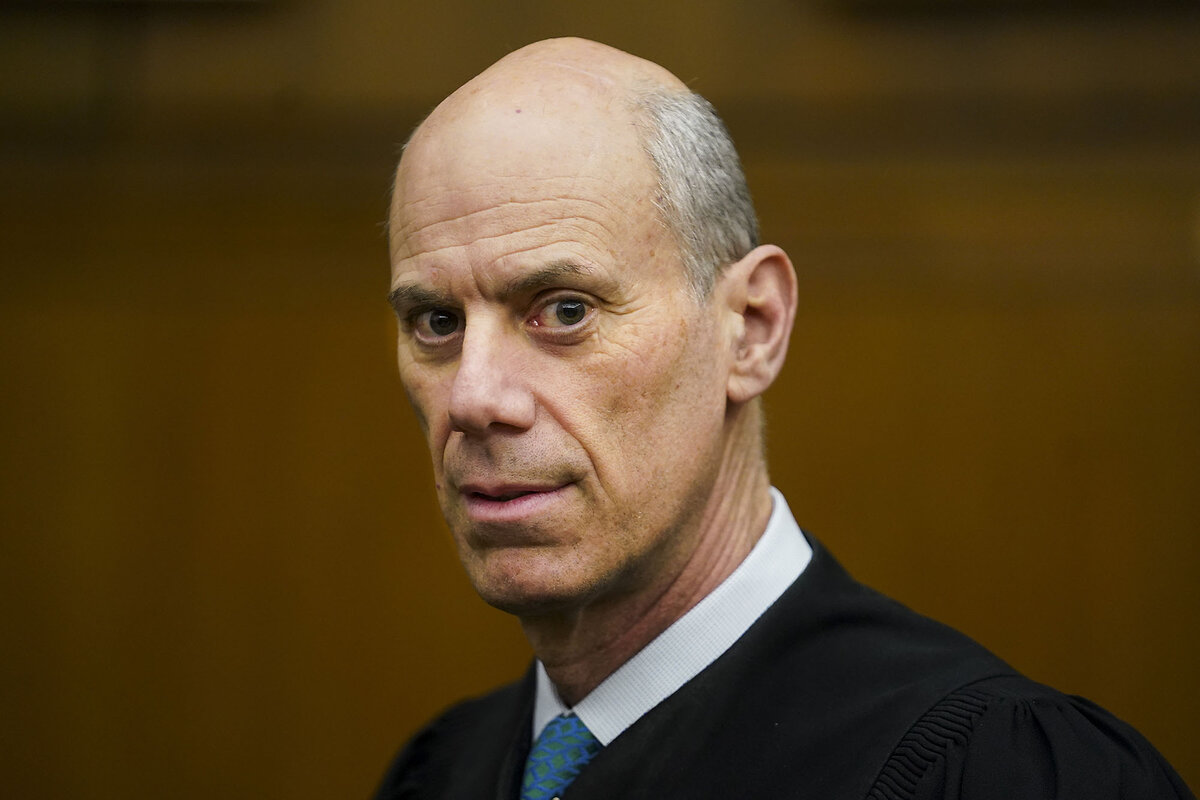So, how do you know if a country is in a constitutional crisis?
Loading...
It’s been the buzzword – or words – of the past two months.
Is the United States in a constitutional crisis? It’s a loaded question to ask, and a difficult one to answer. A constitutional crisis is a fuzzy, intangible, and inherently subjective proclamation. When do you ask that question? How do you answer it?
The question is being raised now because President Donald Trump has been pushing the boundaries of executive power in new and profound ways. He isn’t the first president to do this, but his actions are challenging the constitutional separation of powers.
Why We Wrote This
A story focused onWhat is a constitutional crisis, and is the United States in one? Our justice reporter looks at when a “maximalist view of the power of the executive” tips into unconstitutionally defying or discrediting other branches of government.
Can a president, through executive orders, reinterpret a provision of the Constitution? Or declare that certain immigrants can be deported without a court hearing? Can officials under the president unilaterally freeze funding authorized by Congress? Or lay off thousands of federal employees? Or gut federal agencies created by Congress?
The Republican-controlled Congress has permitted, and in some cases applauded, these broad assertions of executive power. Courts have been more skeptical, however. Some of Mr. Trump’s actions, judges have said, may be unlawful. The president and his allies have responded by publicly criticizing judges and accusing them of bias and corruption – criticism that prompted a rare public rebuke from Chief Justice John Roberts.
These are the ingredients, some scholars argue, for a constitutional crisis.
What is a constitutional crisis?
There is no universally accepted definition of a constitutional crisis, but there is consensus around the hallmarks of one.
Such a crisis would feature direct conflict among the three pillars of America’s constitutional system: the legislative branch, the executive branch, and the judicial branch. So that no single branch becomes too powerful, the Constitution articulates how the government’s power is divided among them.
But the Constitution doesn’t articulate everything. This silence can breed a constitutional crisis.
“We have a constitutional crisis when we have a situation for which the Constitution does not provide a ready answer,” says Thomas Griffith, a retired federal judge who spent 15 years on the U.S. Court of Appeals for the District of Columbia.
“What we have going on right now, from my perspective, is an administration taking a maximalist view of the power of the executive,” he adds. Contesting that view in court, as is happening now, means the dispute “is unfolding the way the Constitution imagines.”
Is America facing a crisis now?
Well, some scholars argue that the Constitution didn’t imagine quite what’s been happening over the past two months.
Many of the Trump administration’s most disruptive actions have been carried out by the U.S. Department of Government Efficiency (DOGE) – part of Mr. Trump’s promise to reduce waste and fraud in the federal government. The agency, housed within the Executive Office of the President, has no Senate-confirmed leaders or clear rules around oversight or accountability. The president has the power to create this kind of office. However, judges have been ruling that DOGE has been meddling too much, and too fast, with Congress’ power to authorize funds and create federal agencies.
Ensuring compliance with these orders has also been a challenge for some judges.
The government has released frozen funds, per a court order, but slowly. The government has rehired federal employees, but many of them have been immediately placed on paid administrative leave. Citing rarely used provisions of immigration law, the government has detained and deported immigrants – both documented and unauthorized – without a hearing. Despite judicial rulings that these actions may be unlawful, immigrants have been denied access to lawyers and their families.
And sometimes the timing of orders has created gray areas. On Tuesday, a doctoral student at Tufts University was detained on the street by Department of Homeland Security agents. By the time a judge ordered that she be allowed to remain in Massachusetts, she had already been transported to a Louisiana detention center.
Mr. Trump has said repeatedly that his administration will not defy court orders, but “It sure feels like the White House and its allies are feeling for soft points,” says Gregg Nunziata, executive director of the Society for the Rule of Law and a veteran conservative lawyer.
Meanwhile, he adds, these legal maneuvers are being paired with a “campaign [by] the president and his allies to delegitimize the judiciary.”
Why is the legitimacy of the courts important?
As judges have ruled against the Trump administration, Trump officials and congressional Republicans have accused them of partisan bias. Judges were already facing increasing threats of physical violence. Now, federal judges are being threatened with impeachment as well.
After Judge James Boasberg began investigating “possible defiance” of his order blocking the administration from deporting immigrants to El Salvador without a court hearing, Mr. Trump wrote on social media that the judge “should be impeached.”
Chief Justice Roberts responded in an unusual public statement. “For more than two centuries, it has been established that impeachment is not an appropriate response to disagreement concerning a judicial decision,” he said. “The normal appellate review process exists for that purpose.”
In a Fox News interview hours after that, Mr. Trump agreed – up to a point.
“You can’t do that,” he said, referring to ignoring the courts. “However, we have bad judges.”
The president and his allies have noted that courts have issued more nationwide pauses on Trump policies than for other recent presidents. And some observers argue that if there is a constitutional crisis, it’s being stoked by the judicial branch, not the executive.
“Judicial overreach is a huge problem,” says Thomas Jipping, senior legal fellow at The Heritage Foundation.
“It should be a very rare, unusual thing for a court to step in and put an executive order, or maybe a statute, on hold before it’s even been found to be unlawful,” he adds.
Has the country been in a constitutional crisis before?
You could certainly describe the Civil War as a constitutional crisis. President Abraham Lincoln’s suspension of habeas corpus remains one of the most aggressive executive actions in U.S. history, though a consensus of scholars believes it was justified in a time of crisis. Congress also authorized Lincoln to take that action.
The New Deal era is also often cited as a near constitutional crisis. President Franklin D. Roosevelt expanded executive power in new, sweeping ways to lift the country out of the Great Depression. Congress supported these efforts, but the Supreme Court did not. The justices struck down numerous policies between 1933 and 1937. Roosevelt responded by threatening to expand the high court, thus diluting the conservative majority. The court, meanwhile, started to uphold New Deal policies.
“The president and the Supreme Court were engaged in a dialogue, and for much of it [they] disagreed,” says Kate Shaw, a professor at the University of Pennsylvania Law School.
“But [the Supreme Court] changed course,” she adds. “There were real clashes, [but] they were resolved within the scope of the constitutional system.”
How can a crisis be avoided?
But what the historical episodes illustrate is that a normal functioning of the constitutional separation of powers is central to avoiding, or ameliorating, a constitutional crisis. So far, the Trump administration’s actions have been tested mostly at the lowest level of the federal courts, and primarily in terms of whether actions should be temporarily paused.
Months of litigation over whether the policies themselves are lawful lie ahead. So far, Mr. Trump hasn’t done anything that doesn’t resemble what Roosevelt, for example, did a century ago.
“It’s not that no actor in our system can test the boundaries,” says Professor Shaw. But “A great deal will turn on what the Supreme Court makes of some of these cases.”
Attacking judges and calling for their impeachment is arguably a step beyond a normal testing of constitutional boundaries. Yet that rhetoric is something that Americans may be amenable to. Public confidence in the judiciary has cratered in recent months.
“The biggest backstop the system has is the views of the American people,” says Mr. Nunziata.
How the public responds to what the administration does – and how the Supreme Court rules on it – will be crucial.
In the meantime, “It behooves us all to take a deep breath and view these things reasonably and rationally,” cautions Judge Griffith.
“All of us [need] to dial it back a little bit and have confidence in the process.”
Staff writer Caitlin Babcock contributed to this report from Washington.








